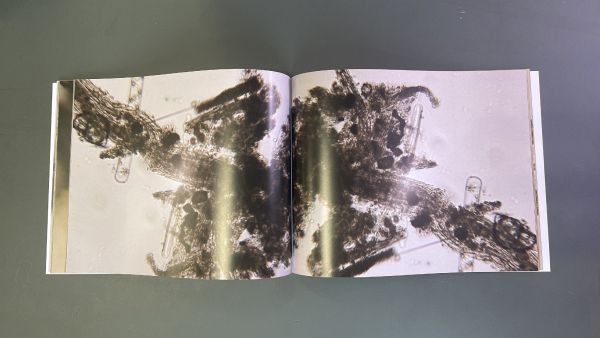(Created page with "<blockquote>'''Symbiotic music'''</blockquote>Sample sound out of physarum policephalum and afterwards make music with it, as if it was another member of the band another idea is make a full band out of organisms. each organism has a specific sound and it sounds depending of the electricity<blockquote>'''Empathy box'''</blockquote>This project is based on the "Empathy box" concept of the book ''Do Androids dream with electronic sheeps?'' from Philip k. Dick. In the book...") |
(final) |
||
| (41 intermediate revisions by 2 users not shown) | |||
| Line 1: | Line 1: | ||
== '''Explorations of the Monad''' == | |||
[[File:46C916BD-ED61-4F85-BE0E-54E3D8C310B7.jpg|600px]] | |||
The sensation of looking through a telescope into the vastness of the night might also be experienced under the light of the microscope. The microscope functions as a portal to the sub-universe of the micro, of organised forms hidden in the larger terms of "more complex" organisms or elements. | |||
According to the philosopher Leibniz, everything that exists is derived from an initial indivisible substance called monad, which by its qualities lacks figure, extension, beginning or end. Constant contraction and collision of this substance or energy, reacting with each other, creates compound substances which are what we know as reality. | |||
The book offers a magnified look at microscopic life, revealing a hidden world and inviting to reflect on the complexity of life at its tiniest level. Through structures found under the microscope, the idea of monad is explored by speculating on its shape, texture and colours. The images were taken with the aid of the microscope and extracted from samples of different water found in Weimar including ponds around Ilm park and hidden fountains. | |||
<gallery> | |||
File:6826C550-B7C0-44AE-A623-E7A5EC8BAB75.jpg | |||
File:A891863B-E6EF-4B4A-AEE1-CBABC29924A6.jpg | |||
File:Coverjgc.png | |||
File:Captura de Pantalla 2024-07-07 a las 22.37.30.png | |||
File:Captura de Pantalla 2024-07-07 a las 22.37.08.png | |||
File:Captura de Pantalla 2024-07-07 a las 22.37.16.png | |||
File:Captura de Pantalla 2024-08-12 a las 12.53.59.png | |||
File:Captura de Pantalla 2024-08-12 a las 12.54.13.png | |||
File:Captura de Pantalla 2024-08-12 a las 12.54.20.png | |||
File:Captura de Pantalla 2024-08-12 a las 12.54.06.png | |||
File:Captura de Pantalla 2024-08-12 a las 12.54.28.png | |||
File:Captura de Pantalla 2024-08-12 a las 12.54.34.png | |||
File:Captura de Pantalla 2024-08-12 a las 12.55.11.png | |||
File:Captura de Pantalla 2024-08-12 a las 12.55.23.png | |||
File:Captura de Pantalla 2024-08-12 a las 12.54.51.png | |||
File:Captura de Pantalla 2024-08-12 a las 12.55.04.png | |||
File:Captura de Pantalla 2024-08-12 a las 12.52.50.png | |||
File:Captura de Pantalla 2024-08-12 a las 12.52.57.png | |||
File:Captura de Pantalla 2024-08-12 a las 12.53.08.png | |||
File:Captura de Pantalla 2024-08-12 a las 12.53.23.png | |||
File:Captura de Pantalla 2024-08-12 a las 12.53.15.png | |||
</gallery> | |||
<blockquote>Images are created to tell stories | |||
But we can make images have a memory of their own. | |||
What happens when we use a scientific image and generate a narrative with them, a narrative in intimacy. | |||
The scientific image becomes the poetic </blockquote> | |||
Latest revision as of 11:11, 12 August 2024
Explorations of the Monad
The sensation of looking through a telescope into the vastness of the night might also be experienced under the light of the microscope. The microscope functions as a portal to the sub-universe of the micro, of organised forms hidden in the larger terms of "more complex" organisms or elements.
According to the philosopher Leibniz, everything that exists is derived from an initial indivisible substance called monad, which by its qualities lacks figure, extension, beginning or end. Constant contraction and collision of this substance or energy, reacting with each other, creates compound substances which are what we know as reality.
The book offers a magnified look at microscopic life, revealing a hidden world and inviting to reflect on the complexity of life at its tiniest level. Through structures found under the microscope, the idea of monad is explored by speculating on its shape, texture and colours. The images were taken with the aid of the microscope and extracted from samples of different water found in Weimar including ponds around Ilm park and hidden fountains.
Images are created to tell stories
But we can make images have a memory of their own.
What happens when we use a scientific image and generate a narrative with them, a narrative in intimacy.
The scientific image becomes the poetic





















